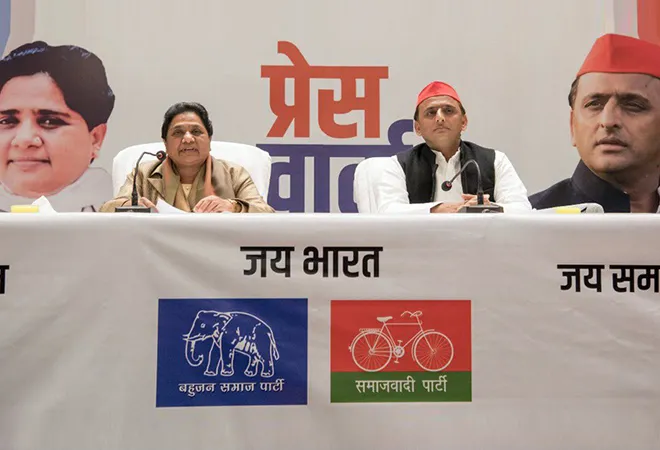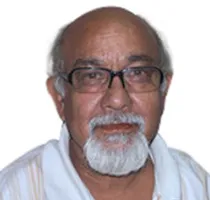
Now, one thing has become clear in Uttar Pradesh, the biggest State of the country, which sends 80 members to Lok Sabha. The coming general elections will mainly see a triangular fight, between the Bharathiya Janata Party (BJP) and its allies, the Bahujan Samaj Party (BSP) and the Samajwadi Party (SP) alliance and the Congress and its allies.
On 12 January, the two regional parties – the BSP and SP – announced that they would fight the general elections together, both parties contesting 38 seats each. This announcement by BSP supremo Mayawati and SP chief Akhilesh Yadav removed whatever confusion was there regarding whether these former arch rivals would put up a combined fight to take on the BJP which had won 71 seats in the last general elections, playing an anchor role in getting the party absolute majority in the Lok Sabha for the first time.
Addressing a press conference jointly, Mayawati and Akhilesh Yadav said the Congress would not be part of their alliance. However, the leaders said they would not field their party candidates in Amethi and Rai Bareli – the Lok Sabha constituencies of Congress president Rahul Gandhi and UPA chairperson Sonia Gandhi.
A week later, the Rashtriya Lok Dal (RLD), a western UP based party that largely represents the dominating Jat community of the region, also became part of the BSP-SP alliance. The RLD may contest on three or four seats with the SP parting with one or two seats from its agreed quota of 38 seats.
In the last general elections in 2014, there was a four-cornered contest, when the BJP bagged an unprecedented 71 seats.
It may be recalled here that the Bharatiya Janata Party (BJP) had won 71 parliamentary seats out of the total 80 seats in a four cornered contest in 2014 Lok Sabha polls giving the saffron party an unprecedented majority. Opposition parties -- the BSP, SP, Congress and the RLD --had suffered crushing defeats. The SP won only five seats, the Congress 2, the BSP and the RLD nothing. Two remaining seats had gone to the BJP’s NDA partner, Apna Dal.
Now, both the BSP and the SP are fighting their respective existential battles because if the alliance does not win over 50 seats, then Mayawati as well as Akhilesh are going to face major challenges to their political career as well as ambitions. Maywati, who has been out of power since 2012, could win merely 19 seats in the 2017 assembly elections, which also gave massive majority to the BJP and brought in Yogi Adityanath as the State Chief Minister.
Akhilesh, a former chief minister, too is facing serious challenges as his uncle Shivpal Yadav, who has floated a separate party after parting ways with him, is breathing down his neck. If Akhilesh fails to put up a good performance, a large number of party leaders and cadres may desert him and cross over to his uncle party.
The coming together of the SP and the BSP, that had polled 22.2 percent and 19.6 percent of popular votes respectively in the 2014 general elections, pose a serious challenge for the BJP that had polled 42.3 percent of the votes.
In the 2017 State assembly elections, the two parties together had polled 44.2 percent while the BJP’s popular vote, despite winning an unprecedented 384 seats, stood at 36.2 percent.
Making a guesstimate based on the arithmetic of the past election often goes wrong and therefore a closer look at the prevailing ground realities is required to understand the impact of the SP-BSP alliance.
By not making the Congress part of the alliance, Mayawati has taken a calculated political risk. With her determination not to cede any political space to the Congress, the BSP supremo is aiming to achieve twin objectives. First, her sight is set on the prime ministerial chair and this she can do only when she can win maximum number of seats from the UP. Second, she has to keep the Congress down to strengthen her bargaining strength.
Insiders, who have been part of the negotiations between the two parties, say Akhilesh Yadav was initially very keen to keep the Congress within the alliance. But Mayawati convinced Akhilesh Yadav of the futility of bringing the country’s oldest party in.
Maywati’s argument for keeping the Congress out was that while the BSP and SP vote is transferable, the Congress vote is generally not transferred to its alliance partners. The Congress benefits from alliance. The other argument she extended was that if the Congress becomes strong in UP, then we (SP and BSP) would be weakened in the process. She is understood to have told the SP leader that it is easier to negotiate with the weak than with the strong.
Mayawati further said that the voter base of the Congress and the BJP was common in many ways as both were preferred by upper castes. If the Congress was contesting large number of seats, then it will eat into the BJP votes, benefitting the SP-BSP candidates.
Notwithstanding Mayawati’s set of arguments for not including the Congress in the opposition alliance, the BSP-SP tie-up has given a breather to the BJP in the State, as a triangular contest is far better for the saffron party than a direct one-to-one fight.
In direct fight, there is a possibility for the BJP’s tally to come down to about a dozen seats from the 71 that it had won in 2014. But in a largely triangular contest, the ruling party at the Center as well as in the State can expect to bag two dozen odd Lok Sabha seats.
It has been observed that the electorate votes differently in assembly and national elections. Therefore, it would be wrong to presume that the electorate would gravitate towards the SP-BSP alliance if they desire to defeat the BJP. Voters, who are disappointed rather disillusioned with the BJP, would prefer to opt for the Congress. In their calculation, this applies more to minority voters, who may think the Congress alone can stop the BJP from coming back to power.
In the 2004 Lok Sabha elections, the BJP’s tally in the lower house from UP had come down from 29 to 10 while the SP had won 35 and the BSP 19 seats. In the 2009 general elections, the Congress increased its strength to 21 from nine members it had in 2004, while the BJP’s tally stood at 10. The BSP had 20 and the SP 23 MPs in that Lok Sabha.
For the Congress, whether winning 21 seats in 2009 was a one-time phenomenon or not is impossible to guess. In 2014, the Congress came second in six Lok Sabha seats -- of Saharanpur, Ghaziabad, Lucknow, Kanpur, Barabanki and Khushinagar. These seats were won by the BJP. The SP and BSP came only behind the Congress in all the six seats.
The strength of the BSP-SP alliance, in which the Rashtriya Lok Dal is also a minor partner contesting four seats, is primarily its caste identity. In an emotive election or in a wave kind of situation, caste barriers are often broken as the electorate tends to rise above caste considerations to vote for a cause or party or a leader.
This type of voting pattern was evident in 1971, 1984, 1989, 1999 and 2014 general elections. The 1977 general elections were not included because the wave did not spread beyond the Vindhyas. In the absence of a wave or a definite emotive issue, voting takes place along caste lines.
The voting behavior of the Muslim electorate is also going to be very crucial in determining the outcome of large number of Lok Sabha constituencies. By keeping the Congress out of the alliance, Mayawati seems to have posed a serious dilemma for the minority community, particularly the Muslims, who comprise more than 19 percent of the state’s population.
The Muslims, particularly after nearly five years of the Modi government and two years of the Yogi Adityanath government, would like to vote for a party that can defeat the BJP. And the first choice of Muslim electorate is the Congress, though they may vote for the SP-BSP alliance candidate where they think the Congress is not in position to defeat the BJP. There is a lack of trust between the Muslim community and the SP and the BSP because both these parties have hobnobbed with the BJP in the past.
With the firming of the SP-BSP-RLD alliance and the Congress contesting majority of seats, the BJP is definite to face a big challenge. Since the alliances are State specific, the BJP would find it impossible to build a common national narrative. The election is going to be fought on State issues.
The BJP would have loved to turn the contest Narendra Modi versus Rahul Gandhi, but alas the Congress is fighting in many States alone. West Bengal, Odisha, Tamil Nadu, Telengana, Andhra Pradesh and UP are some of the States where the Congress is not the first rival of the BJP.
UP may or may not give yet another prime minister but it is definite that the UP will play a crucial role in deciding who is going to lead the country for another five years.
The views expressed above belong to the author(s). ORF research and analyses now available on Telegram! Click here to access our curated content — blogs, longforms and interviews.




 PREV
PREV


